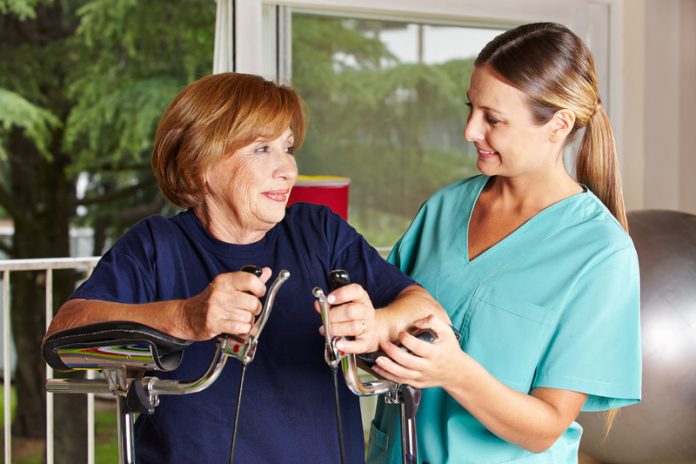Writing on behalf of the Chartered Society of Physiotherapy, Dr. Bhanu Ramaswamy highlights how physiotherapy can help manage the symptoms of Parkinson’s
Parkinson’s is a neurological condition that affects one in every 500 people across the United Kingdom.
Currently there is no known cure and as the function of the brain is known to gradually decline, the condition can be portrayed through a negative viewpoint. Anecdotal and published material from people diagnosed with the condition however stress that correctly timed education and available support networks enable them to live more normal lives, and improve the quality of their experience with Parkinson’s.
This happens through interdependent relationships with differing groups of people (family, friends, peers through the voluntary sector, health professionals, social care providers and employers), from the time around the diagnosis, and ongoing through the course of the condition.
Progression of Parkinson’s
The symptoms and progression of Parkinson’s differ between individuals, sometimes making diagnosis difficult. It may take a few years before the atypical Parkinson’s conditions are distinguishable from idiopathic Parkinson’s, the most common form. There are certain symptoms however that are experienced more commonly, categorised according to their effect on movement (motor symptoms) or other issues (non-motor symptoms).
Non-motor symptoms can include altered sleep, low mood, altered processing of thoughts, sometimes affecting how easily a person can do more than one task at a time, and memory, plus physiological changes, such as constipation or waxy skin.
The main motor symptoms are slower movement in all people (bradykinesia), involuntary shaking (tremor) in some, usually observed as a hand or foot tremor, and the experience of muscle stiffness (rigidity). The combination of stiffness and slowness can cause movements to become smaller. People may experiences these with altered swallowing and speech (quiet voice, less melodic speech pattern), changes to facial expression to become more mask-like, changes to writing (becomes smaller), as well as smaller, more shuffling steps when walking. The symptoms first appear on one side of the body and are thought to arise as a result of the loss of a chemical called dopamine in the brain, which helps regulate movement. It is important to note that not everyone will experience the vast array of motor or non-motor symptoms.
Physiotherapists work as part of a team of health and social care professionals to support individuals with Parkinson’s in achieving their best possible lifestyle. This might involve providing information about Parkinson’s, including a link to the vital social network provided through the voluntary sector. Here, peers have the experience to answer questions about Parkinson’s and what the future may hold from one perspective, just as the professionals can offer their skills and knowledge from a different angle. People don’t die directly because of Parkinson’s, and therefore, they should be encouraged to take up opportunities to share ideas on how to manage living with the condition with others through a wide support network.
Managing Parkinson’s through physiotherapy
The National Institute of Health and Care Excellence (NICE) advocate physiotherapy for people with Parkinson’s. Physiotherapists help people affected by injury, illness or long-term conditions through movement and exercise, manual therapy, education and advice. Where people cannot ‘recover’ from a condition such as Parkinson’s, a role of physiotherapy is to enable people to remain independent and well for as long as possible, regardless of age, manage discomfort or pain, and prevent the complications from a less active lifestyle that occurs secondary to the main condition.
A thorough assessment and dialogue between the physiotherapist and person with Parkinson’s will identify goals and life priorities to enable planning of areas that require intervention, especially focusing on the ability to carry out everyday tasks based on their unique needs.
In general, the benefits of physiotherapy for people with Parkinson’s and the people most close to them include improving or maintaining fitness through exercise (especially for balance, strength and flexibility); helping with movement control to maintain independence and prevent or manage falls; help alleviating pain, and ensuring posture is optimised as this affects breathing, swallowing, tasks such as turning (in bed or when walking) and balance, including tasks such as walking or getting up out of a chair.
Whilst the medical management of Parkinson’s is through the prescription of drugs, exercise and movement therapies are also necessary to help manage many Parkinson’s symptoms.
When someone is newly diagnosed, the emphasis of physiotherapy is to support the individual to identify activities to take on or keep up with, to stay fit, active and healthy, thus minimising the impact of Parkinson’s later in life. This includes the use of leisure and third sector programmes to promote general fitness and inclusion in community activity. For people with Parkinson’s, it is vital to consider taking exercise daily as one would take medication. No exercise done correctly has been demonstrated as harmful, and when done properly, it can help recalibrate slow and small movement (motor symptoms) associated with Parkinson’s. In addition to the physical benefits of training targeted to symptoms of Parkinson’s, exercise has been shown to help in managing non-motor symptoms, and physiological (including brain) and mental health.
There may be a point as the individual ages, as the condition progresses, or when Parkinson’s is only one of their medical conditions when some of the symptoms of Parkinson’s may have a bigger impact on day-to-day life. At this point a physiotherapist can problem-solve with the individual to consider their needs. They may then teach family and friends strategies to help with better movement that minimise injury to anyone, with an emphasis on everyone staying active and safe. Treatments focus on teaching strategies to overcome difficulty in generating automatic movement and thought that are affecting daily function (dual tasking). For example, external cueing, such as auditory, tactile, visual and sensory cues, or attentional strategy training (e.g. mental rehearsal and visualisation of movement).
For more information see below:
For a physiotherapist: the European Physiotherapy Guidelines for Parkinson’s disease. A free publication (contributed to by 17 European countries, including the UK representatives of the Chartered Society of Physiotherapy), but subject to copyright law.
Reference. KEUS SHJ, MUNNEKE M, GRAZIANO M, ET AL (2014). European Physiotherapy Guideline for Parkinson’s Disease. KNGF/ Parkinson Net, The Netherlands.
Chartered Society of Physiotherapy information page, plus fact sheet.
Also relevant networks for professionals are: ACPIN – the Association of Chartered Physiotherapists in Neurology and AGILE, Chartered physiotherapists working with older people.
Parkinson’s UK fact sheet ‘Physiotherapy and Parkinson’s – order code FS42’ at: https://www.parkinsons.org.uk/content/physiotherapy-andparkinsons-information-sheet or information about Parkinson’s in general at: https://www.parkinsons.org.uk.
Dr. Bhanu Ramaswamy OBE
Independent Physiotherapy Consultant and Honorary Visiting Fellow
Sheffield Hallam University on behalf of Chartered Society of Physiotherapy
b.ramaswamy@shu.ac.uk












“I was diagnosed with Parkinson’s Disease (PD) more than 6 years ago. The tremors started affecting my left hand at first, 3 years later it affected my left leg causing me to walk funny( jerking movements) every time. I was taking levodopa/ cabridopa. In April 2017, I had deep brain stimulation (DBS) procedure done. DBS helps me tremendously but I still have to take levodopa/cabridopa 3 times a day, maximum dose: 25 mg/100mg x2 . I try amantadine but no help. I was approved by my neurologist to try feasible alternatives to my current prescribed medication in the hope of improving my quality of life. and I have to say this natural treatment is a 100% game changer for anyone with PD. It has been a complete turnaround with my balance, mobility,double vision, swollen feet, speech and tremors this is the best that I’ve felt in years. VISIT www. kycuyuhealthclinic. com Thank You Kycuyu.I have stop taking levodopa completely for several months, at least 7 months now, and still feel great.”
I have been diagnosed with Parkinson’s disease since 2010, by the VA. I found that none of the current medications worked (side effects for me). I currently take pramipexole dihydrochloride three times daily. It isn’t working well neither. I still have some tremors. Was on carbidopa levodopa but only lasted 90 minutes then wore off. Down side of carbidopa is after reaching max dosage it will no longer give relief, nothing was working for me and to make matters worse There has been little if any progress in finding a reliable medical treatment for Parkinson’s disease, I was approved by my neurologist to try feasible alternatives to my current prescribed medication in the hope of improving my quality of life. and I have to say this natural treatment is a 100% game changer for anyone with PD. It has been a complete turnaround with my balance, mobility, double vision, swollen feet, speech and tremors this is the best that I’ve felt in years. I have stop taking levodopa completely for several months, at least 7 months now, and still feel great.